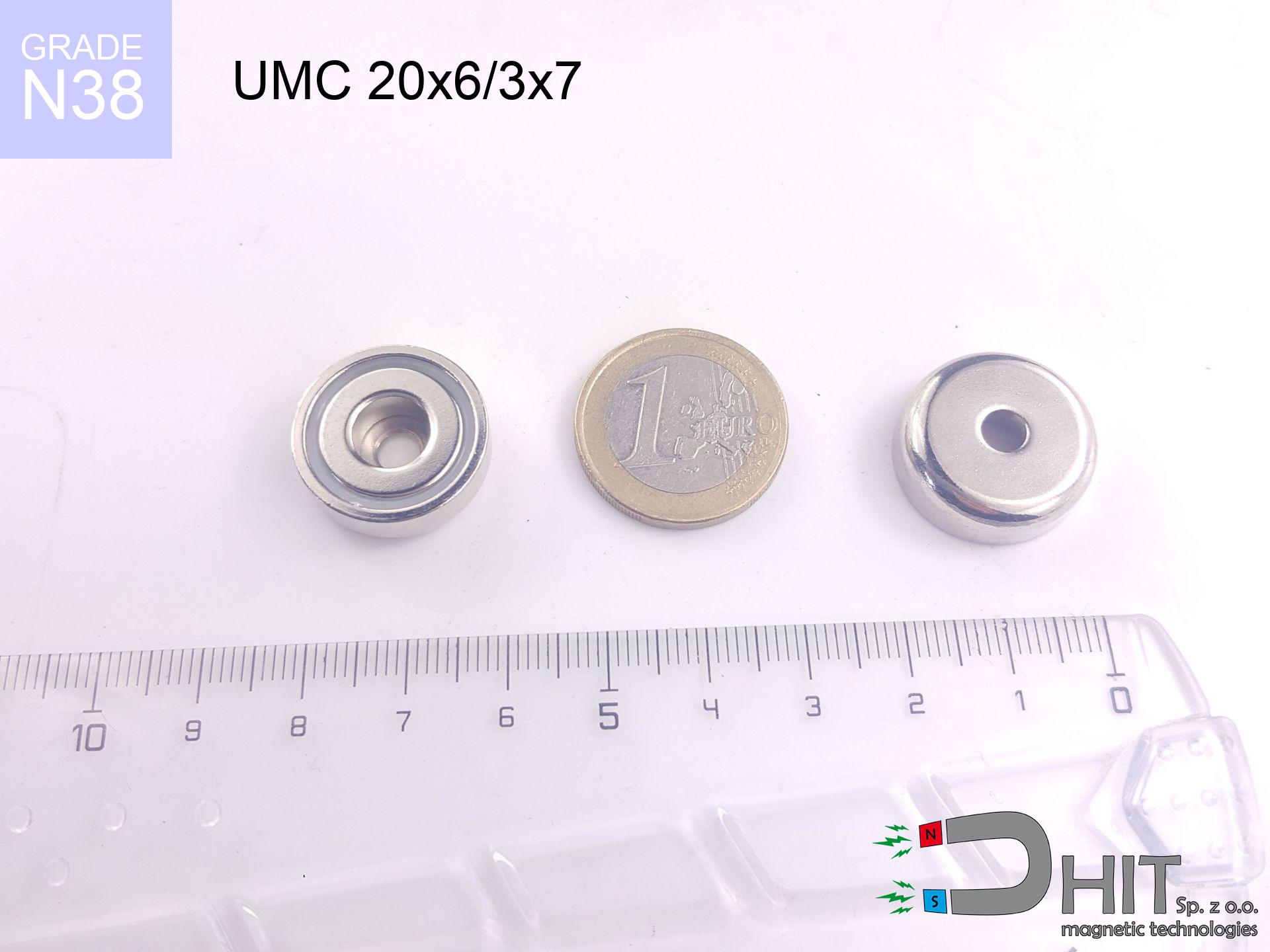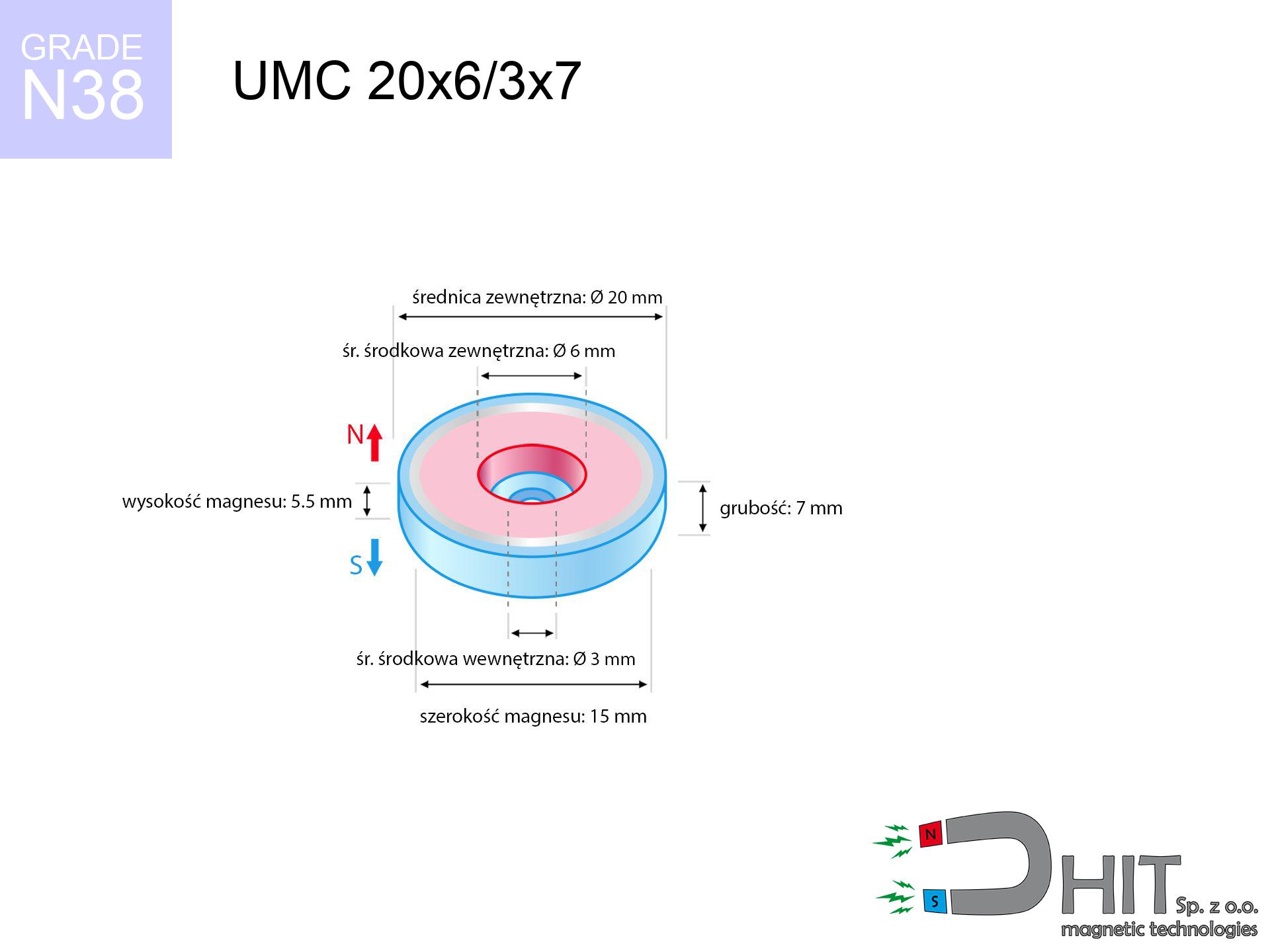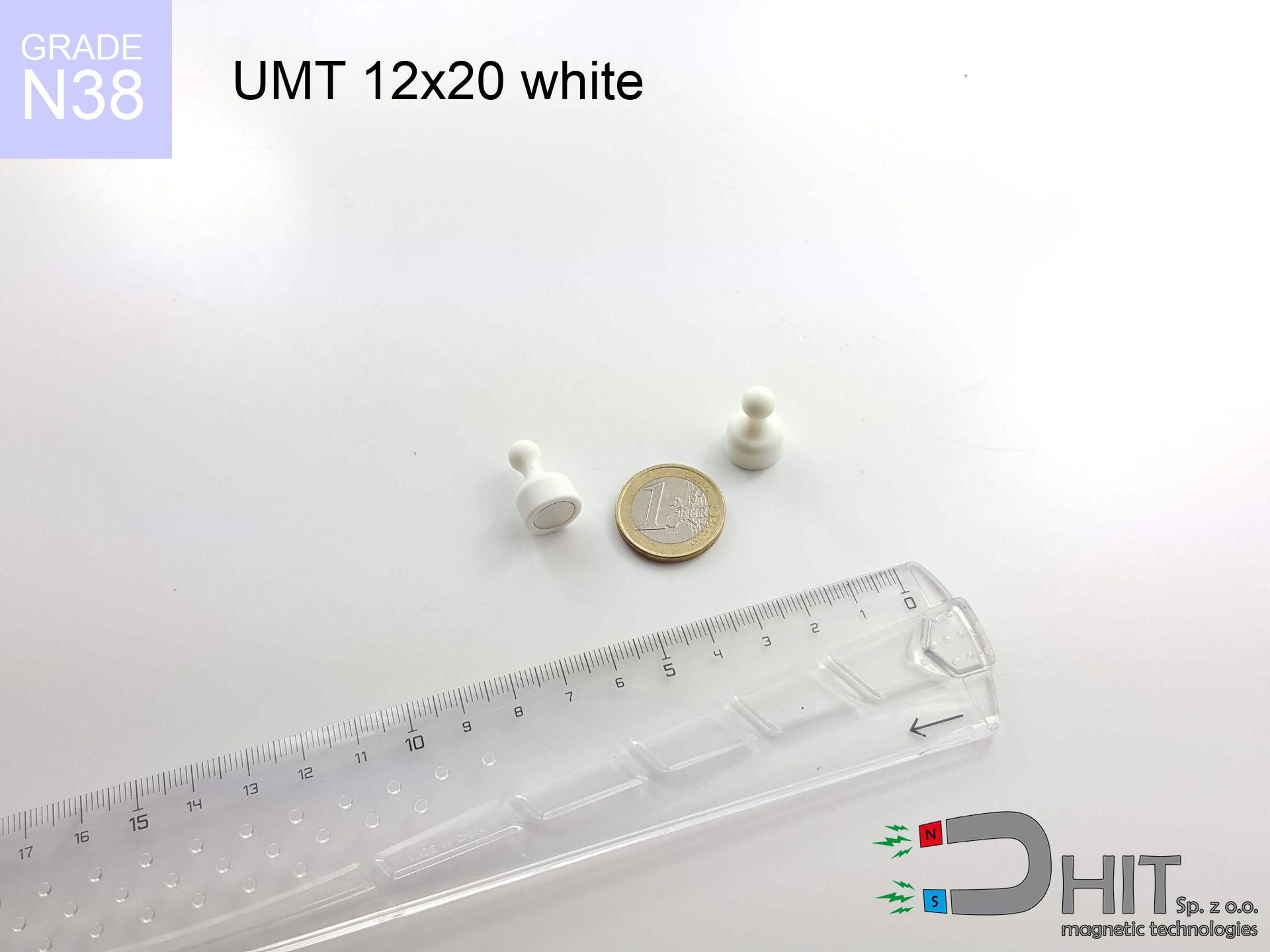UMC 20x6/3x7 / N38 - cylindrical magnetic holder
cylindrical magnetic holder
Catalog no 320407
GTIN/EAN: 5906301814634
Diameter
20 mm [±1 mm]
internal diameter Ø
6/3 mm [±1 mm]
Height
7 mm [±1 mm]
Weight
12 g
Load capacity
6.00 kg / 58.84 N
Coating
[NiCuNi] Nickel
6.99 ZŁ with VAT / pcs + price for transport
5.68 ZŁ net + 23% VAT / pcs
bulk discounts:
Need more?
Give us a call
+48 22 499 98 98
alternatively send us a note through
inquiry form
the contact page.
Parameters as well as structure of a neodymium magnet can be reviewed using our
power calculator.
Orders placed before 14:00 will be shipped the same business day.
Detailed specification - UMC 20x6/3x7 / N38 - cylindrical magnetic holder
Specification / characteristics - UMC 20x6/3x7 / N38 - cylindrical magnetic holder
| properties | values |
|---|---|
| Cat. no. | 320407 |
| GTIN/EAN | 5906301814634 |
| Production/Distribution | Dhit sp. z o.o. |
| Country of origin | Poland / China / Germany |
| Customs code | 85059029 |
| Diameter | 20 mm [±1 mm] |
| internal diameter Ø | 6/3 mm [±1 mm] |
| Height | 7 mm [±1 mm] |
| Weight | 12 g |
| Load capacity ~ ? | 6.00 kg / 58.84 N |
| Coating | [NiCuNi] Nickel |
| Manufacturing Tolerance | ±1 mm |
Magnetic properties of material N38
| properties | values | units |
|---|---|---|
| remenance Br [min. - max.] ? | 12.2-12.6 | kGs |
| remenance Br [min. - max.] ? | 1220-1260 | mT |
| coercivity bHc ? | 10.8-11.5 | kOe |
| coercivity bHc ? | 860-915 | kA/m |
| actual internal force iHc | ≥ 12 | kOe |
| actual internal force iHc | ≥ 955 | kA/m |
| energy density [min. - max.] ? | 36-38 | BH max MGOe |
| energy density [min. - max.] ? | 287-303 | BH max KJ/m |
| max. temperature ? | ≤ 80 | °C |
Physical properties of sintered neodymium magnets Nd2Fe14B at 20°C
| properties | values | units |
|---|---|---|
| Vickers hardness | ≥550 | Hv |
| Density | ≥7.4 | g/cm3 |
| Curie Temperature TC | 312 - 380 | °C |
| Curie Temperature TF | 593 - 716 | °F |
| Specific resistance | 150 | μΩ⋅cm |
| Bending strength | 250 | MPa |
| Compressive strength | 1000~1100 | MPa |
| Thermal expansion parallel (∥) to orientation (M) | (3-4) x 10-6 | °C-1 |
| Thermal expansion perpendicular (⊥) to orientation (M) | -(1-3) x 10-6 | °C-1 |
| Young's modulus | 1.7 x 104 | kg/mm² |
Material specification
| iron (Fe) | 64% – 68% |
| neodymium (Nd) | 29% – 32% |
| boron (B) | 1.1% – 1.2% |
| dysprosium (Dy) | 0.5% – 2.0% |
| coating (Ni-Cu-Ni) | < 0.05% |
Sustainability
| recyclability (EoL) | 100% |
| recycled raw materials | ~10% (pre-cons) |
| carbon footprint | low / zredukowany |
| waste code (EWC) | 16 02 16 |
View also offers
Advantages as well as disadvantages of Nd2Fe14B magnets.
Benefits
- They have constant strength, and over around ten years their performance decreases symbolically – ~1% (in testing),
- They show high resistance to demagnetization induced by presence of other magnetic fields,
- Thanks to the glossy finish, the plating of nickel, gold-plated, or silver-plated gives an elegant appearance,
- Magnets are distinguished by very high magnetic induction on the outer side,
- Through (adequate) combination of ingredients, they can achieve high thermal strength, enabling operation at temperatures reaching 230°C and above...
- Thanks to the possibility of flexible molding and adaptation to unique needs, magnetic components can be manufactured in a wide range of geometric configurations, which amplifies use scope,
- Significant place in innovative solutions – they find application in hard drives, brushless drives, diagnostic systems, as well as other advanced devices.
- Relatively small size with high pulling force – neodymium magnets offer impressive pulling force in small dimensions, which enables their usage in compact constructions
Limitations
- Brittleness is one of their disadvantages. Upon strong impact they can fracture. We recommend keeping them in a steel housing, which not only protects them against impacts but also raises their durability
- When exposed to high temperature, neodymium magnets experience a drop in power. Often, when the temperature exceeds 80°C, their strength decreases (depending on the size and shape of the magnet). For those who need magnets for extreme conditions, we offer [AH] versions withstanding up to 230°C
- They oxidize in a humid environment. For use outdoors we advise using waterproof magnets e.g. in rubber, plastic
- We suggest a housing - magnetic holder, due to difficulties in producing threads inside the magnet and complex shapes.
- Health risk resulting from small fragments of magnets can be dangerous, when accidentally swallowed, which is particularly important in the context of child health protection. Additionally, small elements of these products are able to complicate diagnosis medical in case of swallowing.
- Due to expensive raw materials, their price is higher than average,
Pull force analysis
Maximum holding power of the magnet – what contributes to it?
- using a base made of mild steel, acting as a circuit closing element
- possessing a massiveness of min. 10 mm to avoid saturation
- with a surface perfectly flat
- under conditions of gap-free contact (surface-to-surface)
- during pulling in a direction perpendicular to the mounting surface
- at temperature room level
Determinants of practical lifting force of a magnet
- Gap (betwixt the magnet and the plate), since even a very small clearance (e.g. 0.5 mm) results in a decrease in lifting capacity by up to 50% (this also applies to paint, corrosion or dirt).
- Force direction – remember that the magnet has greatest strength perpendicularly. Under sliding down, the holding force drops significantly, often to levels of 20-30% of the maximum value.
- Wall thickness – thin material does not allow full use of the magnet. Magnetic flux penetrates through instead of converting into lifting capacity.
- Plate material – mild steel gives the best results. Higher carbon content reduce magnetic permeability and holding force.
- Smoothness – full contact is possible only on smooth steel. Rough texture reduce the real contact area, reducing force.
- Temperature influence – hot environment weakens pulling force. Too high temperature can permanently damage the magnet.
Holding force was checked on a smooth steel plate of 20 mm thickness, when a perpendicular force was applied, whereas under shearing force the holding force is lower. In addition, even a slight gap between the magnet and the plate lowers the holding force.
Safety rules for work with NdFeB magnets
Fragile material
Despite metallic appearance, the material is brittle and cannot withstand shocks. Do not hit, as the magnet may shatter into sharp, dangerous pieces.
Health Danger
Medical warning: Neodymium magnets can turn off pacemakers and defibrillators. Do not approach if you have medical devices.
Allergic reactions
Studies show that nickel (standard magnet coating) is a potent allergen. For allergy sufferers, refrain from touching magnets with bare hands or choose versions in plastic housing.
Machining danger
Fire warning: Neodymium dust is explosive. Do not process magnets without safety gear as this risks ignition.
Hand protection
Mind your fingers. Two large magnets will snap together immediately with a force of massive weight, destroying anything in their path. Exercise extreme caution!
Thermal limits
Avoid heat. Neodymium magnets are susceptible to heat. If you need resistance above 80°C, ask us about HT versions (H, SH, UH).
Keep away from children
NdFeB magnets are not toys. Eating several magnets can lead to them pinching intestinal walls, which poses a severe health hazard and necessitates immediate surgery.
Data carriers
Very strong magnetic fields can destroy records on credit cards, hard drives, and storage devices. Maintain a gap of at least 10 cm.
Safe operation
Handle magnets consciously. Their huge power can surprise even professionals. Stay alert and do not underestimate their force.
Threat to navigation
Be aware: rare earth magnets generate a field that confuses sensitive sensors. Maintain a safe distance from your mobile, tablet, and GPS.




![BM 950x180x70 [4x M8] - magnetic beam BM 950x180x70 [4x M8] - magnetic beam](https://cdn3.dhit.pl/graphics/products/bm-950x180x70-4x-m8-ves.jpg)
![UMGW 16x13x5 [M4] GW / N38 - magnetic holder internal thread UMGW 16x13x5 [M4] GW / N38 - magnetic holder internal thread](https://cdn3.dhit.pl/graphics/products/um-16x13x5-m4-gw-fig.jpg)
![SM 25x200 [2xM8] / N52 - magnetic separator SM 25x200 [2xM8] / N52 - magnetic separator](https://cdn3.dhit.pl/graphics/products/sm-25x200-2xm8-jas.jpg)


